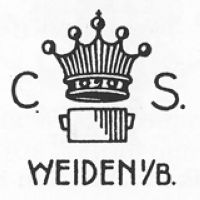
Image 010251-01-01
Used between 1911 and 1914 only, can also be found with Schutzmarke addition.
Christian Wilhelm Seltmann was born 1870 in the small town of Schlottenhof near Arzberg where he had learned some basics by watching his father in the family-owned decoration business. This greatly influenced him and he later become an apprentice in different porcelain factories and gradually learned all aspects of the trade. Working for the factory in Arzberg he successfully designed and decorated porcelain in his spare time and as reward for designing a porcelain bowl which even caught the eye of U.S. customers, he was sent to join the technical school in Teplitz-Schönau.
His work there was quite impressive for such a young talent and at the age of only 26 he even made it factory manager of the Arzberg factory in 1896 where he worked for the next years. But Christian disliked the supervision by the factory owners that did not leave him enough elbow room to include his own ideas and after seeing the success his brother Karl had with the Keramik- und Porzellanfabrik Karl Seltmann in their home town of Schlottendorf he decided to open an own factory together with his oldest brother Johann in 1901.
They decided to establish their business in the town of Vohenstrauß and just a few years later the Porzellanfabrik Johann Seltmann had achieved a very good reputation and employed over 600 workers. But the two brothers often had discussions on how to run the factory and when Johann Seltmann finally wanted to transfer the business into a limited company, Christian decided to leave and open his own business in the town of Weiden in 1910.
Production started with three kilns and just a short time later the rising demand resulted in having two additional kilns installed in 1913; at that time the factory employed 320 workers. As Christian was also very interested in different other areas he founded an own lithographical art establishment in the town of Nürnberg in the year 1920. This was followed in 1921 by the opening of the glassworks Glasfabrik Marienhütte GmbH in Berlin-Köpenick, shortly before Christian Seltmann died as a result of an accident the same year. The Seltmann company was one of the first porcelain manufacturers that not only offered porcelain items but also provided an additional product range of fine glass.
The factory, in 1923 reaching a total of 630 employees, was for the next years run by his widow Katharina Seltmann who in 1928 also managed to achieve stock majority of the Porzellanfabrik Schirnding AG in Schirnding (Bavaria). Shortly afterwards, she retired from business and left the company in the hands of their two sons, arranging that Heinrich received the Schirnding factory. The far more experienced businessman Wilhelm kept the Weiden factory which in 1930 already employed 500 people and later was able to expand by taking over the Porzellanfabrik Krummennaab in 1939 and the Porzellanfabrik Erbendorf in 1940.
Like many other factories during WWII the Seltmann factories lost the greatest part of the workforce to the war effort and were forced to work with a restricted amount of raw materials in combination of having to cope with a drastical change in demand. Following the war, the facilities in Erbendorf and Krummennaab served as quarters for American troops and most parts of the factories were either destroyed or rendered useless during this period as the soldiers adapted the buildings to the need of housing large amounts of people and material. Even if the Seltmann family still had enough resources to help repair the factories afterwards it should not stay unmentioned that a new start would not have been possible without the help of the remaining loyal workers, all of which later received special payments after the company had recovered.
When the company was back in business Seltmann started to modernize his factories from 1953 onwards and in 1957 he became main shareholder of the Königlich privilegierte Porzellanfabrik Tettau GmbH which he then completely took over in 1958, the same year he was given an honorary doctorate by the Technical University in München in respect of his work as president of the Chamber of Commerce.
Wilhelm Seltmann died on September 27th 1967 and left his business in the hands of his family. Like his father before, he hated the thought of a board of directors running a company and so he stated as part of his will that he never wanted the business turned into a limited company or stock corporation and should always remain a family owned business. Needless to say, the heirs respected his wish and the Seltmann group is one of a few remaining larger family-run companies in Germany. The year 1982 saw Mr. Gerhard Döhrling become technical factory manager of the company, a job he continued until his retirement in 2003.
After German reunification in 1990 the Seltmann group (represented by the Tettau branch) took over four old factories in Thuringia: the Aelteste Volkstedter Porzellanmanufaktur and the Unterweißbacher Werkstätten für Porzellankunst as well as the Porzellanmanufaktur Scheibe-Alsbach and the Porzellanmanufaktur Plaue; the whole group today is one of the largest manufacturers of porcelain in Germany.
Names like Ingrid or Helena are the name of the body/series and do not refer to the pattern/decoration. As with most German manufacturers patterns were left unnamed and merely received a numeric pattern code.
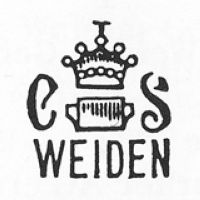
Image 010251-01-01
Used between 1911 and 1924, registered at the RWZR under №·148·638 on September 19th 1911.
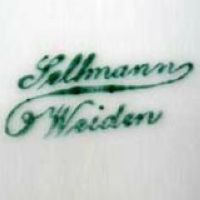
Image 010251-01-01
Used around 1920, reserved for hand painted items. Röntgen disregarded official company info and incorrectly claimed this to be "1954+".
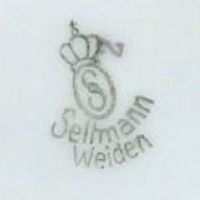
Image 010251-01-01
Used between 1924 and 1946, without any addition.
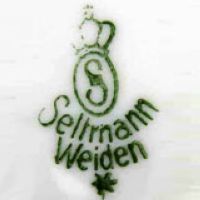
Image 010251-01-01
Used between 1924 and 1946, with a star of sorts.
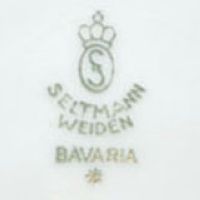
Image 010251-01-01
Used between 1924 and 1946, with "Bavaria".
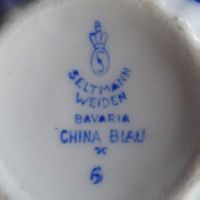
Image 010251-01-01
Used between 1924 and 1946, with "Bavaria" and additional "China Blau" series name.
(Picture: Gary Mann)
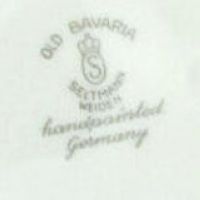
Image 010251-01-01
Used between 1924 and 1946, here with "Old Bavaria" trademark, all above "handpainted" and "Germany".
(Picture: Fran Kerbs)
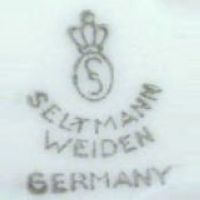
Image 010251-01-01
Used between 1924 and 1946, with "Germany".
(Picture: Fran Kerbs)
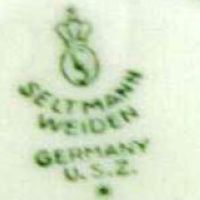
Image 010251-01-01
Used between 1946 and 1948, "Germany" and "USZ" (abbreviation of "US Zone").
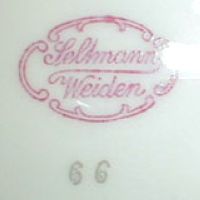
Image 010251-01-01
Used during the 1930s, a hard to find mark version used only on handpainted items.
(Picture: Fran Kerbs)
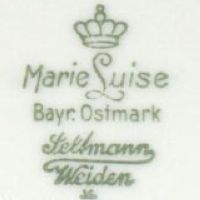
Image 010251-01-01
Used from 1936 onwards, finally registered at the RWZR under №·493·853 on May 26th 1937.
(Picture: Fran Kerbs)
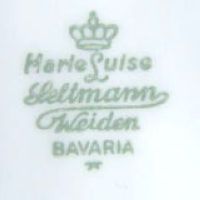
Image 010251-01-01
Used between 1939 and 1945.
(Picture: Fran Kerbs)
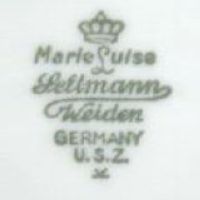
Image 010251-01-01
Used between 1946 and 1949, note the abbreviated "US Zone" (USZ) addition.
(Picture: Fran Kerbs)
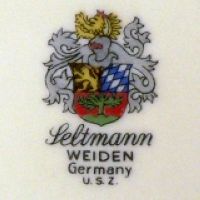
Image 010251-01-01
Used between 1946 and 1949, this mark can only be found on items sold at the PX.
(Picture: Sue Spittle)
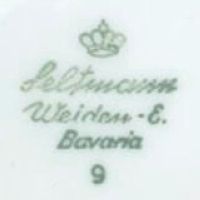
Image 010251-01-01
No exact dates known, but between 1949 and 1954, note "Weiden-E." for Weiden - Erbendorf.
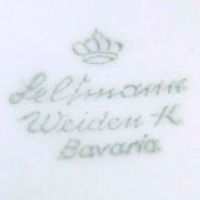
Image 010251-01-01
No exact dates known, but between 1949 and 1954, note "Weiden-K." for Weiden - Krummenaab.
(Picture: Fran Kerbs)
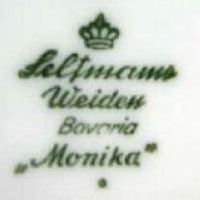
Image 010251-01-01
No exact dates known, but between 1949 and 1954, "Monika" series.
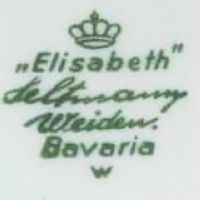
Image 010251-01-01
No exact dates known, but between 1949 and 1954, "Elisabeth" series.
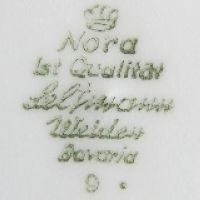
Image 010251-01-01
No exact dates known, but between 1949 and 1954, "Nora" series (with "1st Qualität" addition).
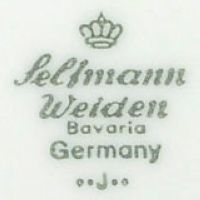
Image 010251-01-01
No exact dates known, but between 1949 and 1954.
(Picture: Fran Kerbs)
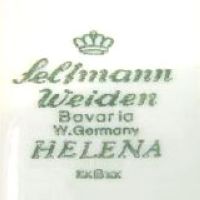
Image 010251-01-01
No exact dates known, but between 1954 and 1990, "Helena" series.
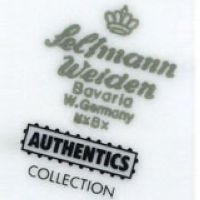
Image 010251-01-01
No exact dates known, but between 1954 and 1990, on items from the "Authentics Collection".
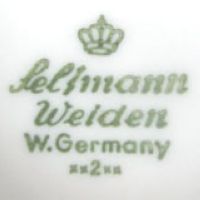
Image 010251-01-01
No exact dates known, but between 1954 and 1990.
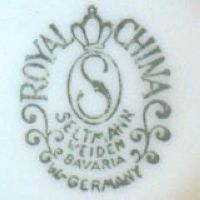
Image 010251-01-01
No exact dates known, but between 1954 and 1990.
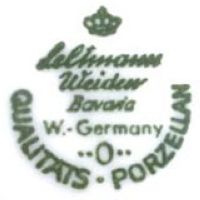
Image 010251-01-01
No exact dates known, but between 1954 and 1990, here in green.
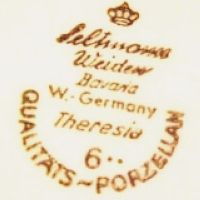
Image 010251-01-01
No exact dates known, but between 1954 and 1990, this time in gold and including the "Theresia" series name.
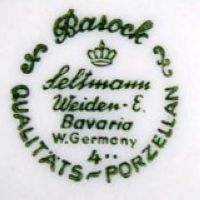
Image 010251-01-01
No exact dates known, but between 1954 and 1990, item from the "Barock" series, note "Weiden-E." for Weiden - Erbendorf.
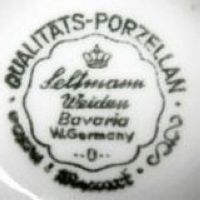
Image 010251-01-01
Mark found on various special series.
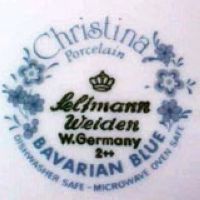
Image 010251-01-01
Mark on a "Christina" set with "Bavarian Blue" decoration.
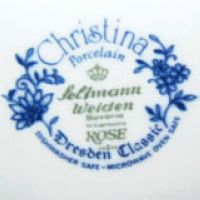
Image 010251-01-01
Mark on a "Christina" set with "Dresden Classics" rose decoration.
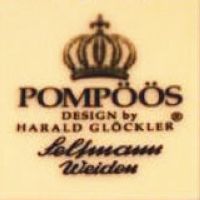
Image 010251-01-01
Special mark version found on items designed by Harald Glöckler for his "Pompöös" brand.
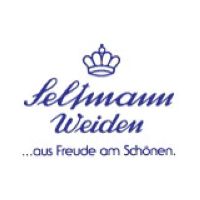
Image 010251-01-01
Company logo used 2008.
© 2004-2026 C.S.Marshall, all rights reserved